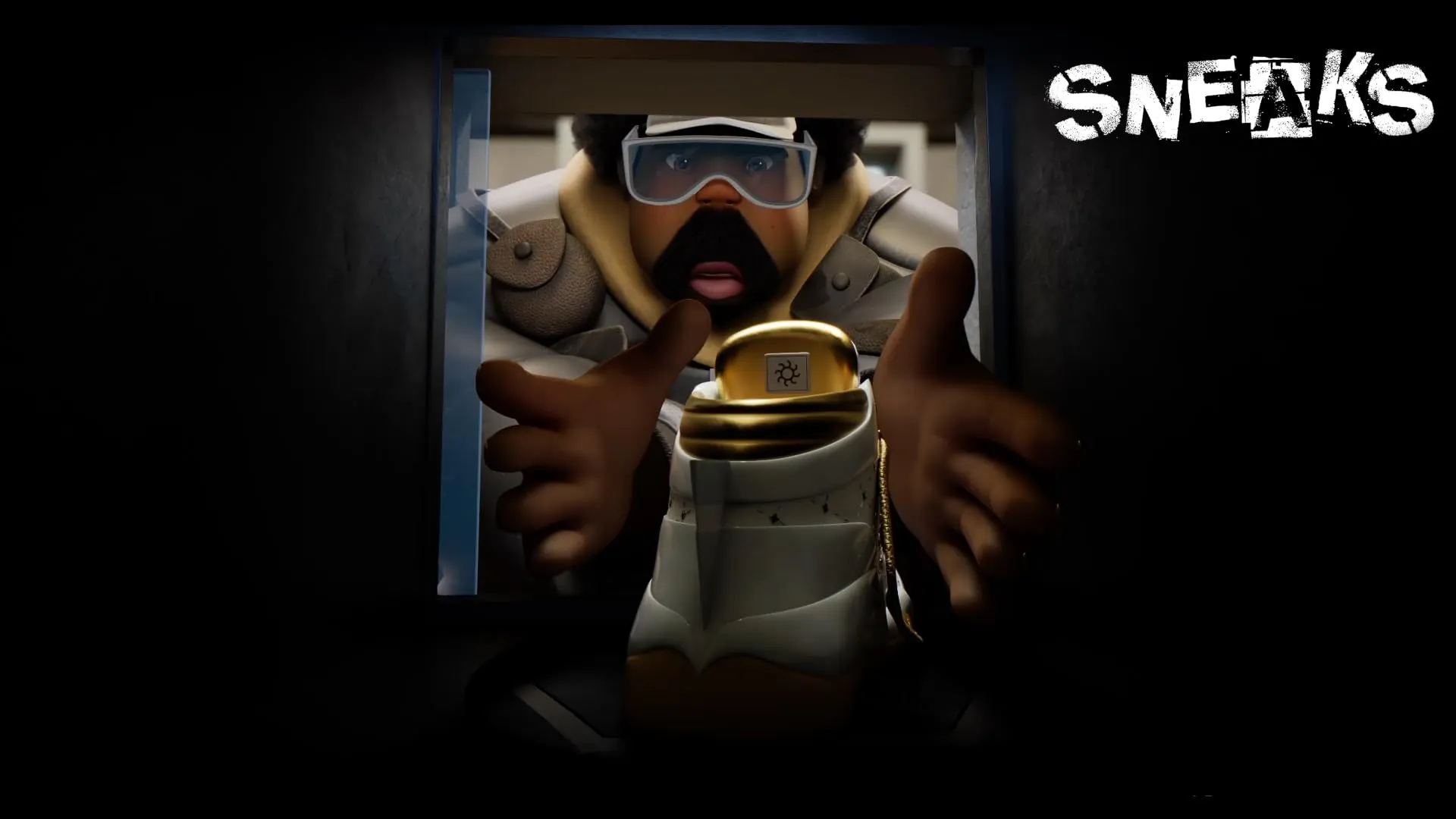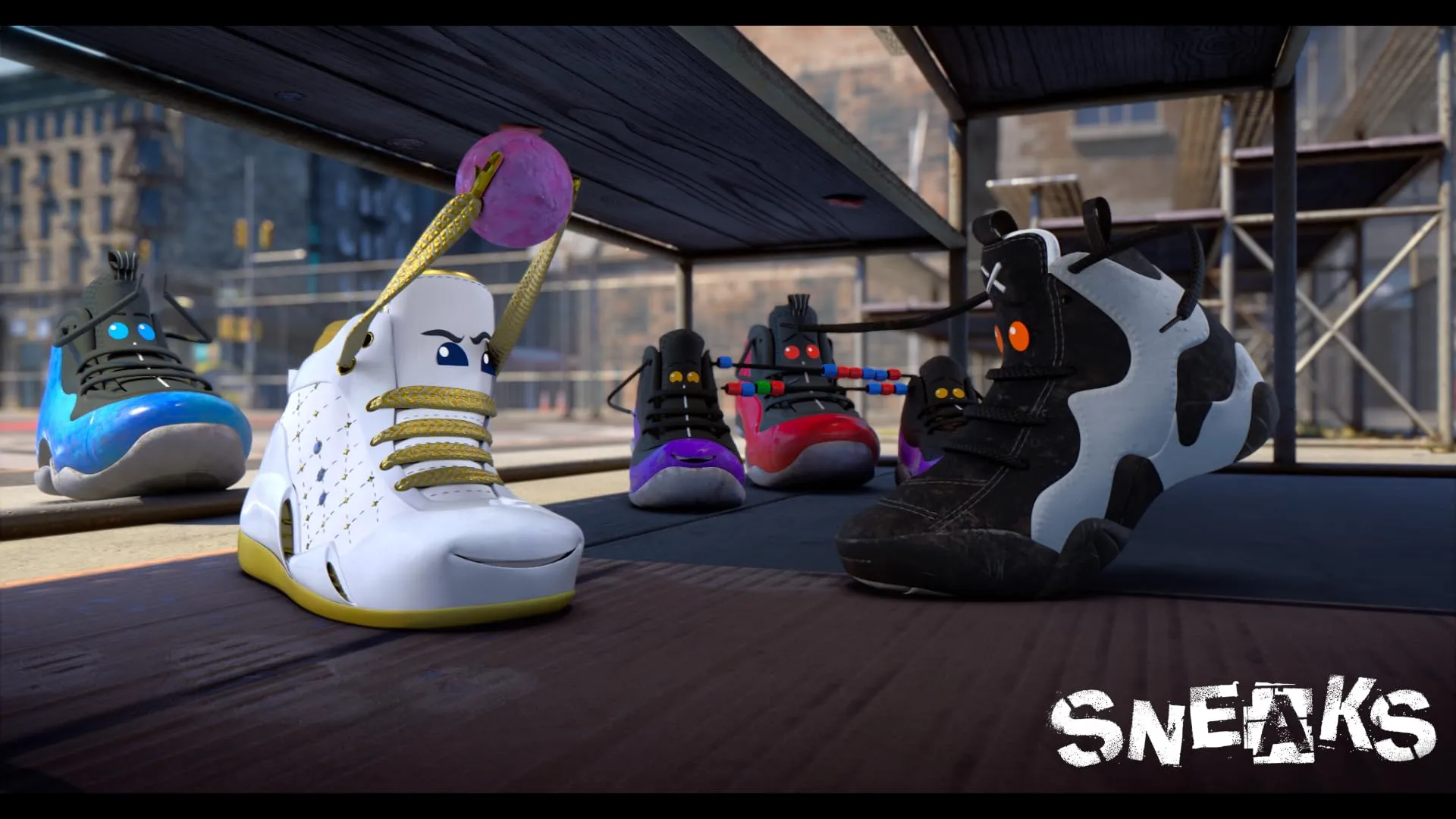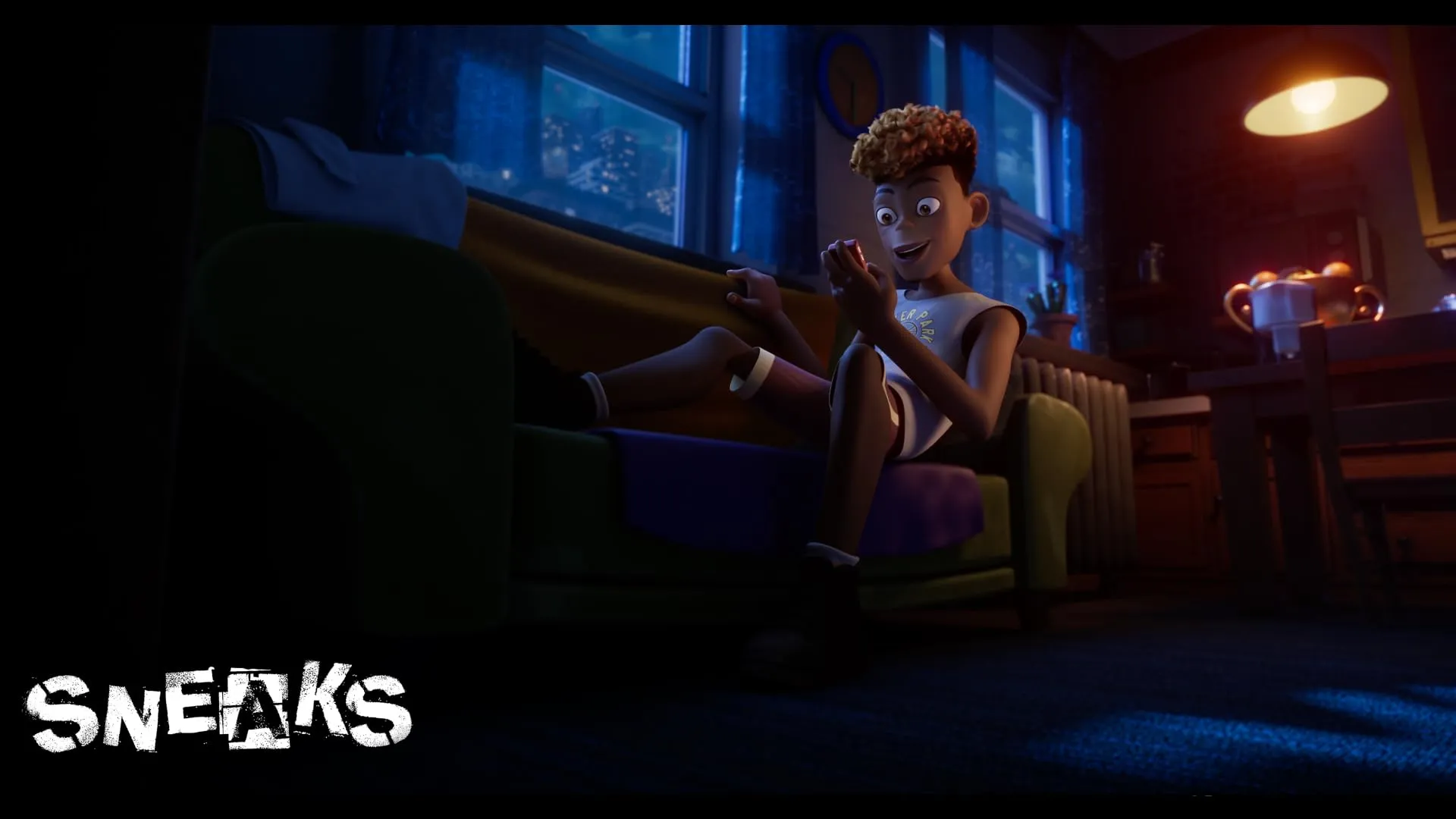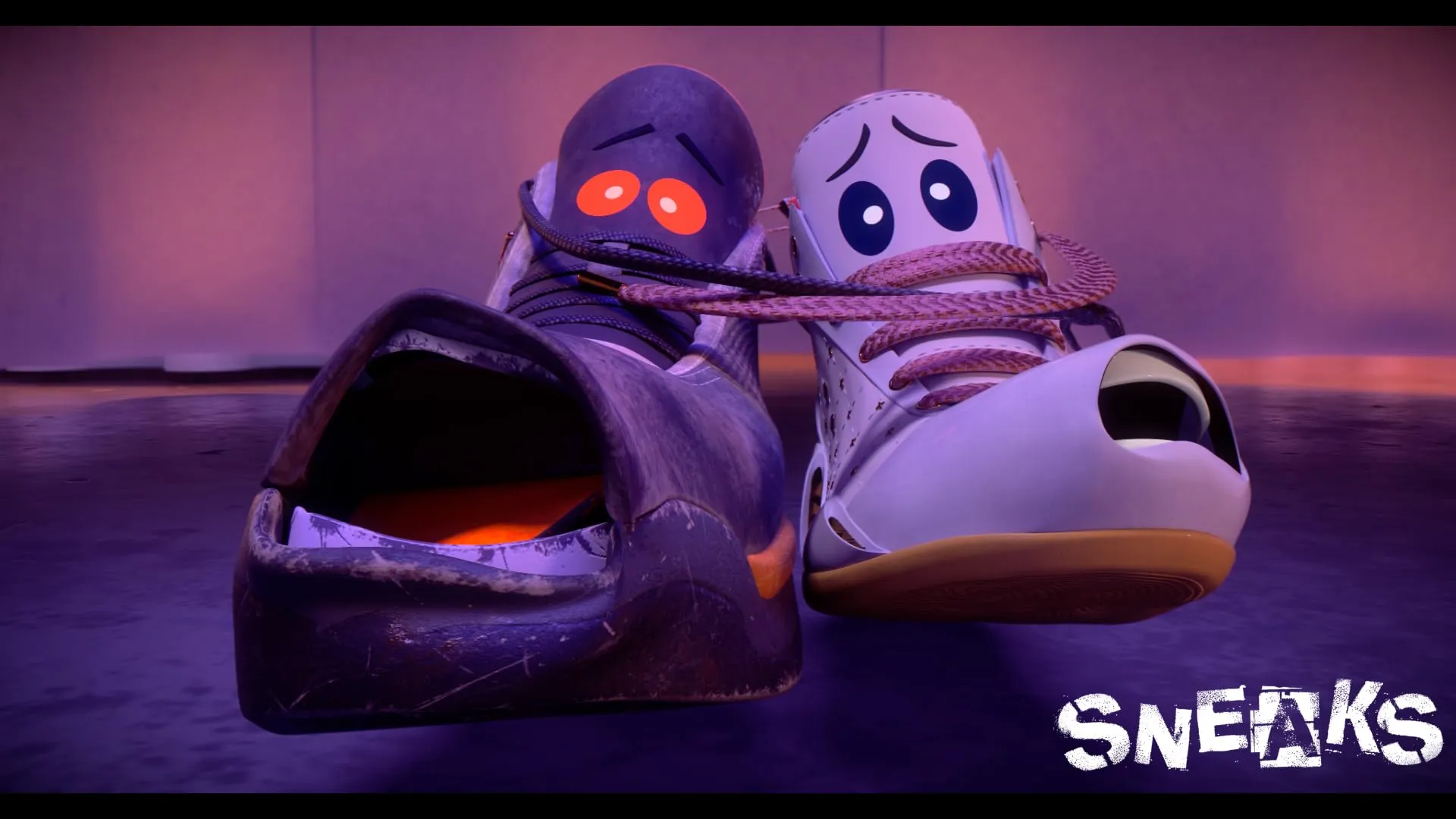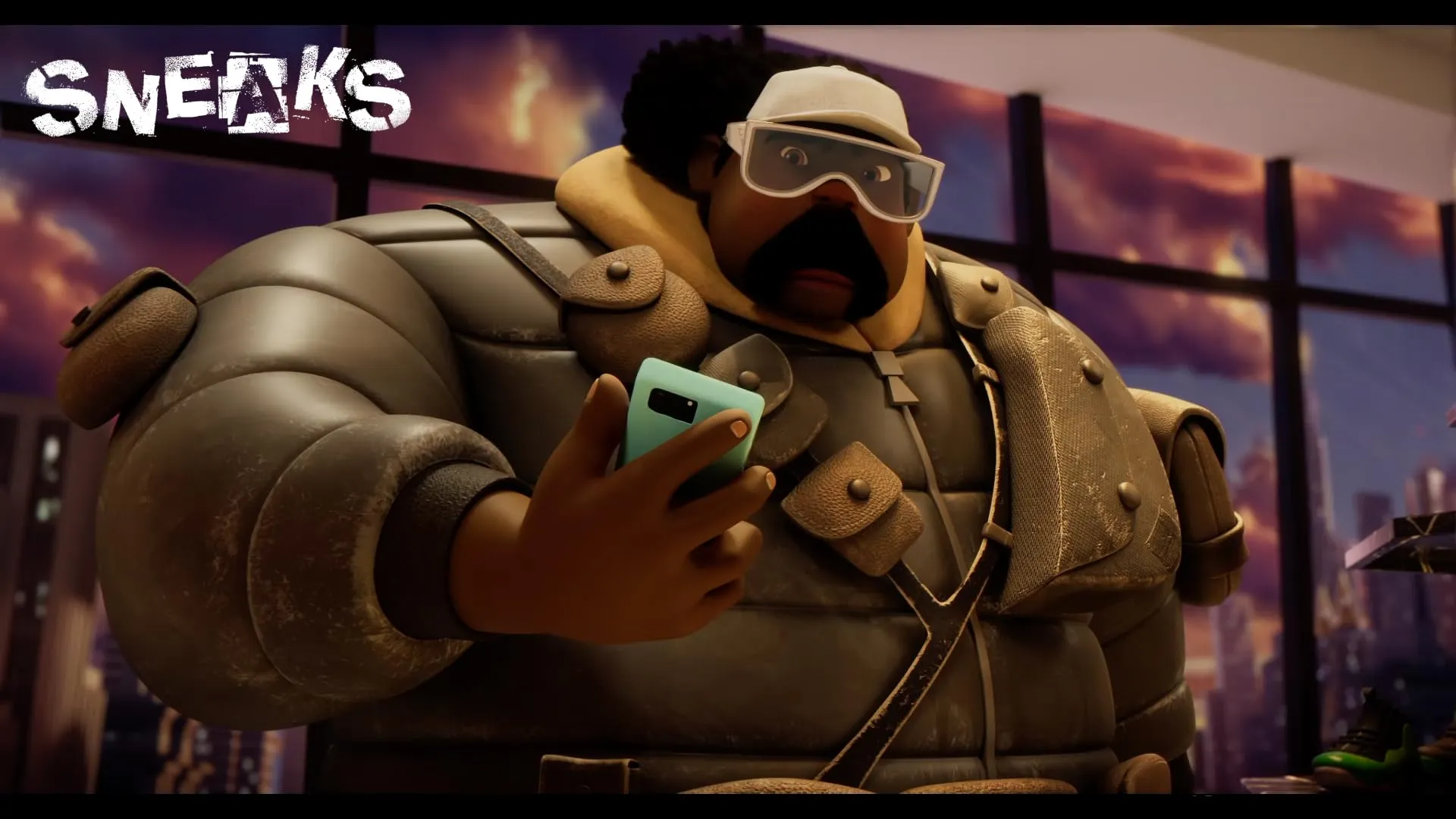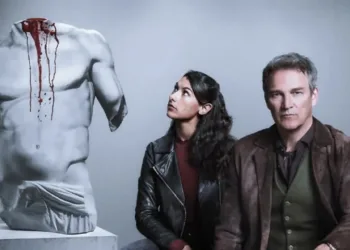Sneaks, directed by Rob Edwards and Christopher Jenkins, opens with the sonic sprawl of New York City—subway rattles, street corner chatter, the ambient pulse of a city that rarely sleeps. Within this stylized urban sprawl, the film introduces a world where sneakers possess consciousness, emotion, and a fractured sense of purpose.
The conceit is knowingly absurd, and yet the movie treats it with earnest visual commitment, inviting its audience to follow a pair of gold-and-white Alchemy 24s, separated by theft and circumstance, across a city drawn with exaggerated lines and kinetic motion.
The central figures—Ty (Anthony Mackie), a self-serious sneaker convinced his destiny lies in permanent display; Maxine (Chloe Bailey), the spirited counterpart who insists on being used—carry the thematic weight of the film. Their voices are not merely animated; they echo the tension between preservation and purpose, between being admired and being worn. Supporting them are the slick-talking J.B. (Martin Lawrence), the formidable Collector (Laurence Fishburne), and Edson (Swae Lee), the teenager whose dreams hang on the shoes he wears.
What unfolds is a blend of buddy comedy, musical interlude, and low-stakes adventure, charged with a soundscape curated by Terrace Martin and Mustard. The film leans into rhythm—of language, of movement, of the city itself—constructing a world where puns fly like loose laces and sneakers whisper philosophies about function, freedom, and the cost of rarity. Its premise may be light, but the ambition in execution suggests something knottier: an exploration of cultural value systems stitched into something as ordinary—and as symbolically loaded—as a pair of shoes.
Stitched Realities and Solemn Dreams
Sneaks builds its world on the soft padding of absurdity, tracing the outline of a familiar animated tradition where objects—whether toys, appliances, or emojis—bear interior lives and emotional needs. Here, it is footwear that steps into consciousness. These sentient sneakers don’t just walk and talk; they argue about self-worth, wrestle with the metaphysics of utility, and slip between identity constructs with surprising fluency.
The premise echoes with cultural implications, drawing from a well-worn but still potent lineage: the object as metaphor, the overlooked commodity as the emotional lens through which audiences reconsider their own rituals of consumption and attachment.
The film’s allegorical stitching is most visible in the binary between preservation and use. Ty, gleaming and unscuffed, aspires to immortality behind glass; Maxine seeks impact, a scuff as signature rather than flaw. That tension parallels the tension in sneaker culture itself—between status and substance, between covetous display and lived-in meaning. The film wades into this space with sporadic clarity, at times articulating a sharp satire of collector culture, at others faltering into chaotic whimsy.
The internal rules governing this world are less clearly defined. Shoes speak, travel, scheme, and lament—yet revert to silence and lifelessness in the presence of humans. It’s a device borrowed without much reinvention, and its logic fractures when examined too closely. The mechanics of the world shift fluidly to meet narrative needs, sacrificing coherence for punchlines or momentum.
New York City, as imagined here, is less a place than a kinetic caricature. Skewed angles and dense textures evoke a sense of elastic geography, a borough-hopping dreamscape charged with exaggerated color and hyperactive pacing. From the glossy sprawl of sneaker expos to the worn courts of Harlem, every locale pulses with cartoon logic and curated grit. A trio of dangling sneakers serves as the film’s unofficial narrators, slinging puns and Shakespearean sendups from their perch on a telephone wire. Their banter, riddled with groan-worthy charm, reinforces the film’s interest in language as material—just another surface to be printed, stretched, or worn thin.
Laced with Persona
At the center of Sneaks are Ty and Maxine, two halves of the coveted Alchemy 24s, whose conflict of values gives the film its clearest emotional line. Ty begins as a gleaming monument to self-preservation—convinced that his finest fate lies under perfect lighting, untouched, unblemished, revered.
His arc is not a descent from idealism but a liberation from stagnation, a reluctant move toward risk and relevance. Maxine, by contrast, is defined by motion. She sees worth in wear, purpose in every step. Her dialogue—earnest without being naïve—positions her as the film’s moral compass, her optimism sharpened by clarity rather than sentimentality. Together, they function as mirror and foil, a pair in name but not in temperament, bound by siblinghood and pulled apart by ideology.
Edson, the teenage owner caught in the gravitational pull of sneaker mythology, enters the film with clear stakes: validation on the court, a shot at confidence, a hope for connection. His arc, however, fades once the shoes are stolen. The narrative leaves him waiting in place while the sneakers propel the action, reducing his character to a symbol of aspiration more than a driver of plot.
The Collector, voiced with gravitas by Laurence Fishburne, looms large but speaks softly. His menace is coded in posture, not complexity, and his motivations—tied to the unseen figure of The Forger—hover just beyond comprehension. The dog, Mercury, skirts the edge of comic relief and mild threat, existing more as texture than character.
J.B., Ty’s reluctant guide through the city’s underbelly, blends charm with abrasion. His intentions are suspect, his presentation slick, but beneath the surface lies an unresolved wound—a partner lost, a purpose scrambled. Martin Lawrence lends J.B. a cadence that skips between bravado and ache, grounding the character’s humor in something brittle.
Among the supporting ensemble, Adriana and Converse O.G. stand out with flourish and warmth, while others—like Britany and her stiletto entourage—serve more as thematic decoration than integral players. The voice cast, however, is tightly tuned. Mackie balances Ty’s shift from pristine to present with restraint; Bailey’s Maxine sparkles with conviction. The film’s musicality owes much to the natural rhythm of its cast—musicians who understand pacing, phrasing, and tone—not simply how to say a line, but how to land it.
Style in Motion
Sneaks approaches its visuals with a self-aware flair, drawing on the elasticity of animation to breathe life into materials not built for expression. The shoes, though inherently limited by form, are stylized into characters with elastic laces for arms, eyelets that emote, and tongues that slip between anatomical logic and cartoon exaggeration.
Jewel-like embellishments and sole textures become visual signifiers of identity and class, translating the coded language of sneaker culture into animated shorthand. The character design leans into archetype—stilettos are elegant and aloof, Jordans swagger with street-born confidence, and retro models wear their obsolescence like faded badges of honor.
The animation itself runs the gamut from inspired to uneven. Some sequences glide with clarity and intention, while others falter under the weight of ambition unmet. There are brushstrokes of more adventurous aesthetics—a choppy, frame-skipped rhythm that nods toward the Spider-Verse films, and geometric, synchronized dance numbers that flirt with Busby Berkeley’s theatrical opulence. Yet these moments rarely settle into a consistent visual language. The film tries on styles like outfits, never quite tailoring them to fit.
When Sneaks finds its rhythm, it’s through motion. Skateboard chases across boroughs, midair pirouettes in park battles, and kinetic exchanges on the basketball court—all channel the physical vocabulary of urban movement. In its best scenes, the choreography fuses propulsion with personality, letting shoes speak through speed and friction.
Beneath the visual playfulness, certain images carry symbolic heft. Ty’s imagined pedestal, bathed in light and untouchable, becomes a shrine to stasis, while Maxine’s scuffed leather tracks her evolving purpose. The contrast between shine and wear, between objecthood and experience, is rendered not through dialogue, but through the surfaces of their bodies. The animation, when it commits, turns metaphor into muscle memory.
Audible Swagger
Sneaks announces itself with sound before image—its sonic palette rooted in a jazz-inflected, hip-hop-charged score by Terrace Martin, paired with original tracks curated by Mustard. The music isn’t an accessory; it’s propulsion. It gives the film its gait, drives the early rush to the Sneakerhead Gala, and lends emotional contour to otherwise skeletal chase sequences. Where the narrative wobbles, the score fills the cracks, holding scenes together with a steady rhythm that feels lived-in, syncopated, and steeped in cultural vernacular.
The sound design extends beyond music into a carefully layered portrait of the city. Subway announcements, the grind of skate wheels, snippets of street banter—these ambient details create a sense of place that feels more grounded than the film’s visual architecture.
New York becomes less a backdrop and more a constant hum, alive with overlapping frequencies. There’s an effort to assign distinct vocal textures to the footwear characters, using modulation and pitch adjustments to distinguish class, age, and attitude. J.B.’s rasp carries wear and defiance; Maxine’s clarity rings with purpose.
Dialogue itself becomes rhythmic. Lines are tossed with the cadence of freestyle—quick, clipped, embedded with internal rhyme and syncopated beats. This musicality infuses the film with a kinetic confidence, even as its narrative structure unravels. The swagger isn’t cosmetic—it’s coded into the film’s voice, its beat, its breath.
Threadbare Myths and Reinvented Soles
The narrative shape of Sneaks adheres to a time-tested formula: an inciting raffle win, the sudden rupture of separation, and an inevitable reunion pitched as emotional crescendo. This three-act scaffold is serviceable, even functional, but the threads tying its subplots together fray under pressure.
Edson’s personal arc—centered on aspiration, confidence, and social footing—is front-loaded with promise, then quietly shelved once the shoes take center stage. Maxine’s escape functions as a parallel plot but lacks friction; her resistance unfolds with mechanical precision. J.B.’s evolution from opportunist to reluctant ally adds texture, though the transformation is more hinted at than earned.
Thematic threads gesture toward heft: identity, purpose, and resilience ripple through the narrative, albeit in shorthand. The question of value—whether it stems from utility or display—sits uneasily at the film’s core. Ty’s fixation on preservation echoes contemporary tensions around commodification, while Maxine’s ethos of use suggests a counter-narrative rooted in participation and wear. Resilience, too, is embedded in the film’s repeated returns: Ty’s setbacks, J.B.’s grudging loyalty, Maxine’s determination to act rather than wait.
Tonally, the film vacillates between earnest moralizing and pun-laden irreverence. The jokes—anchored in footwear references and linguistic slapstick—saturate the script, designed clearly with younger viewers in mind. Yet beneath the wordplay lies a sincerity aimed at meaning-making. Whether that sincerity lands depends less on the delivery than on the audience’s tolerance for tonal oscillation. For children, the surface spectacle may suffice; for adults, the seams between the film’s intentions and its execution are more visible.
Emotionally, Ty’s arc carries the most weight—his shift from pristine idol to engaged participant is drawn with relative care. Maxine’s resolve rarely wavers, making her dependable but narratively static. Edson, meanwhile, disappears into waiting rooms and wistful monologues, his subplot reduced to ambient longing.
Momentum surges during set-piece sequences—skate chases, basketball face-offs—only to stall in exposition-heavy interludes. The film’s tonal leaps, from slapstick to sincerity to spectacle, are rarely smoothed, making its emotional beats feel either rushed or prolonged. Where it moves, Sneaks pulses; where it hesitates, it clunks.
Polish and Wear
Sneaks is animated with the enthusiasm of a film convinced of its own kinetic charm. In flashes, that conviction is justified. The voice work, particularly from Anthony Mackie, Chloe Bailey, and Martin Lawrence, lends emotional shape to characters that might otherwise collapse under their conceptual weight.
Martin’s score and Mustard’s tracks inject momentum where the script meanders, layering texture onto a city rendered more through rhythm than realism. There is wit, too, in the way sneaker types mirror social roles—heels as aristocrats, high-tops as street philosophers—and in how the film occasionally lets metaphor bleed into architecture.
But its polish wears thin under scrutiny. The narrative runs along familiar grooves, recycling the structure of better-told tales without rethreading the logic. Secondary characters flicker with promise but are largely written as props, serving the plot rather than participating in it. The jokes—dense with puns—range from playful to labored, and their sheer volume begins to crowd out the emotional nuance.
Worldbuilding, meanwhile, lacks cohesion: rules shift on cue, undermining the stakes they are meant to enforce. The visual ambition flirts with stylization but never commits, and tonal whiplash undercuts moments of sincerity with sudden slapstick. What remains is a film caught between motion and meaning, trying to sprint through a world it hasn’t fully built.
Full Credits
Directors: Rob Edwards, Christopher Jenkins
Writers: Rob Edwards, Erica Harrell (story by), Dylan Hartman (story by), Desiree Proctor (story by)
Producers: Laurence Fishburne, Helen Sugland, Len Hartman, Gil Cloyd, Meko Yohannes, Jeremy Ross, Robyn Klein
Executive Producers: Jeremy Ross, Meko Yohannes, Robyn Klein, Quavo
Cast: Anthony Mackie (Ty), Chloe Bailey (Maxine), Martin Lawrence (J.B.), Laurence Fishburne (The Collector), Keith David (O.G.), Swae Lee (Edson), Roddy Ricch (The Forger), Ella Mai (Britany), Macy Gray (Adriana), Mustard (Mustard), Quavo (Spike), Young Miko (Tiffany), Kiana Ledé (Shawna), Sam Jay (Gutterball Attendant), Amari McCoy (Shanika), Sky Brown (Sky), Rayssa Leal (Rayssa), Rico Rodriguez (Ice), Chris Paul (Chris Paul), Bobbito Garcia (Bobbito Garcia), Jonathan Kite (Whiz), Donovan Louis Bazemore (Trey), Michael Govier (Shredded Sneak), Andrew Hawkins (Announcer)
Editors: Matt Ahrens, Mirenda Ouellet
Composer: Terrace Martin (score), Mustard (songs)
The Review
Sneaks
Sneaks is a film of competing impulses—visually playful, sonically charged, and occasionally thoughtful, yet weighed down by a derivative plot, scattered focus, and inconsistent execution. Its strongest moments come through sound and movement, where rhythm stands in for coherence and style carries what substance cannot. Despite a committed cast and flashes of conceptual wit, the film never fully escapes the novelty of its premise. It gestures at meaning without quite lacing it together.
PROS
- Strong vocal performances from Anthony Mackie, Chloe Bailey, and Martin Lawrence
- Energetic, jazz- and hip-hop-infused score and soundtrack
- Creative use of sneaker metaphors tied to cultural identity
CONS
- Predictable and derivative storyline
- Underdeveloped supporting characters
- Inconsistent animation quality
- Overuse of puns, many of which fall flat
- Vague world rules and uneven tonal shifts









































